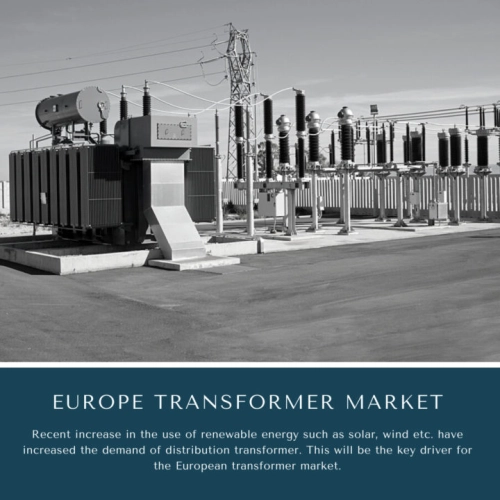
- Get in Touch with Us

Last Updated: Apr 25, 2025 | Study Period: 2024-2030
Transformers are electrical equipment, which consist of two or more number of coils of wire and are used to transfer electrical energy via changing magnetic field. Transformers are used for different purposes in electric power system like Generation, Transmission, Distribution and utilization of electrical power.

Depending on the purpose, transformers can be classified into different types-

Europe transformer market is segmented by-
These transformers are used in high voltage transmission networks i.e. 400 KV, 200 KV, 110 KV, 66 KV, 33 KV. Since power canât be transferred at high voltage to the customers, so the power is stepped down using step-down power transformer. They are mainly rated above 200 MVA.
These transformers have appx. 100% efficiency and mainly installed at generating station and transmission substations. They are relatively bigger in size as compared to distribution transformers.
These transformers have low voltage rating i.e. 11 KV, 6.6 KV, 3.3 KV, 440 V, 230 V and are rated less than 200 MVA. These are used in distribution network to step down the voltage level to suitable value for the use of consumer.
Recent increase in the use of renewable energy such as solar, wind etc. have increased the demand of distribution transformer. This will be the key driver for the European transformer market.
Various eco-design statistics consideration given by European government as amendments in order to improve efficiency in electricity transmission.
A power transformer with a highest voltage for equipment not exceeding 1,1 kV.
A power transformer with a highest voltage for equipment higher than 1,1 kV, but not exceeding 36 kV and a rated power equal to or higher than 5 kVA but lower than 40 MVA.
A power transformer with a highest voltage for equipment exceeding 36 kV and a rated power equal to or higher than 5 kVA, or a rated power equal to or higher than 40 MVA regardless of the highest voltage for equipment.
New eco-design of medium and large power transformers will minimize the losses and improve the transmission efficiency as per the amended commission regulation of Europe.
Depending on the type of dielectric insulation material, transformers may be classified in to two types-
In this type of transformers, winding sand core are immersed in oil, in a tank with radiators. Here oil act as both insulator and cooling agent. Common application of these type of transformer are-
Oil filled sealed transformers are used in distribution networks (MV/LV) and in installation up to 52 kV having power rating up to 2.5 MVA. Few manufacturers have built this kind of transformers for power rating up to 30 MVA.

These falls under the category of dry type transformers, where air is used as a cooling agent instead of oil. This type of transformers is most suitable where distribution of energy requires absolute safety. These requires less maintenance and are safer as compared to oil type transformers. Possess very less space and are simple in design with onsite replacement of winding s feasibility.
Dry type transformers are used in-
| Sl no | Topic |
| 1 | Market Segmentation |
| 2 | Scope of the report |
| 3 | Abbreviations |
| 4 | Research Methodology |
| 5 | Executive Summary |
| 6 | Introduction |
| 7 | Insights from Industry stakeholders |
| 8 | Cost breakdown of Product by sub-components and average profit margin |
| 9 | Disruptive innovation in the Industry |
| 10 | Technology trends in the Industry |
| 11 | Consumer trends in the industry |
| 12 | Recent Production Milestones |
| 13 | Component Manufacturing in US, EU and China |
| 14 | COVID-19 impact on overall market |
| 15 | COVID-19 impact on Production of components |
| 16 | COVID-19 impact on Point of sale |
| 17 | Market Segmentation, Dynamics and Forecast by Geography, 2024-2030 |
| 18 | Market Segmentation, Dynamics and Forecast by Product Type, 2024-2030 |
| 19 | Market Segmentation, Dynamics and Forecast by Application, 2024-2030 |
| 20 | Market Segmentation, Dynamics and Forecast by End use, 2024-2030 |
| 21 | Product installation rate by OEM, 2023 |
| 22 | Incline/Decline in Average B-2-B selling price in past 5 years |
| 23 | Competition from substitute products |
| 24 | Gross margin and average profitability of suppliers |
| 25 | New product development in past 12 months |
| 26 | M&A in past 12 months |
| 27 | Growth strategy of leading players |
| 28 | Market share of vendors, 2023 |
| 29 | Company Profiles |
| 30 | Unmet needs and opportunity for new suppliers |
| 31 | Conclusion |
| 32 | Appendix |